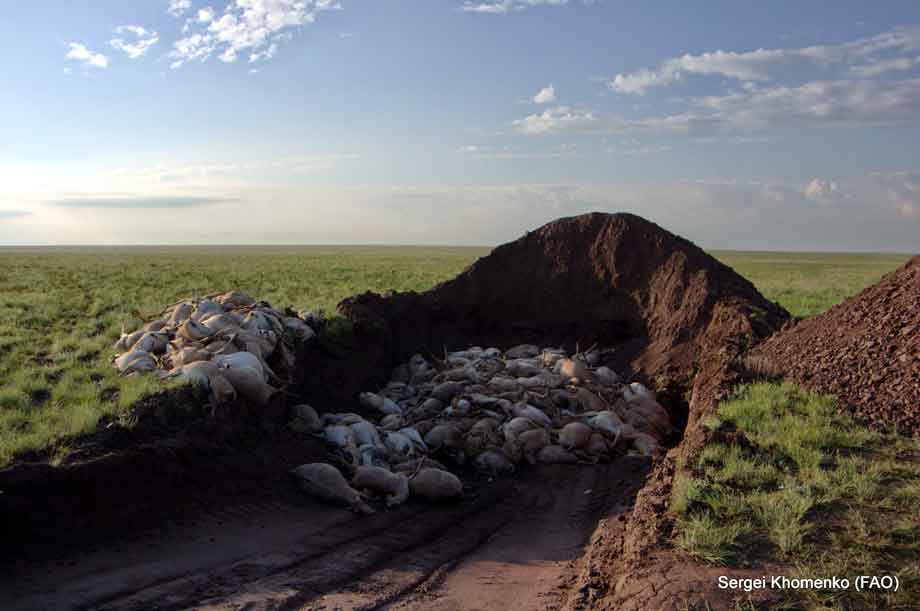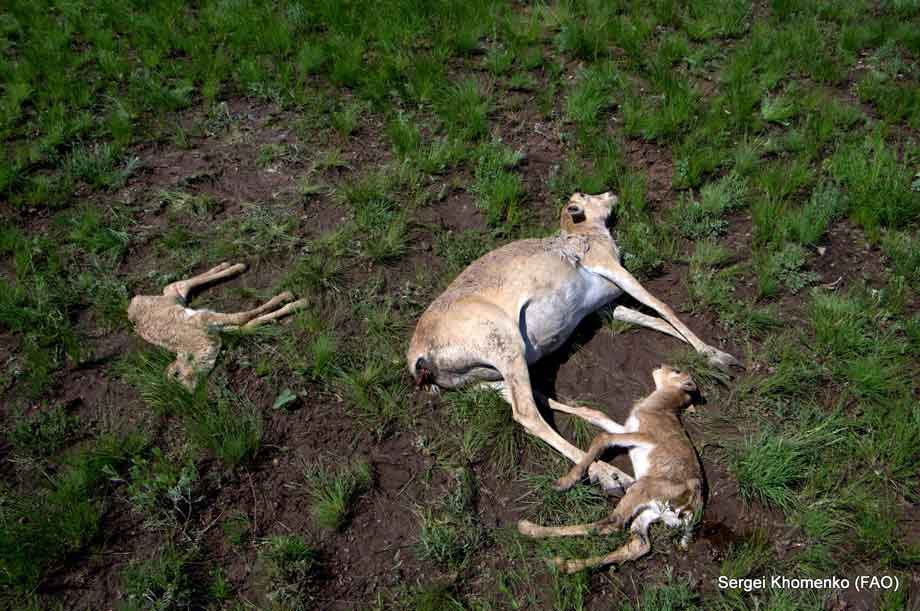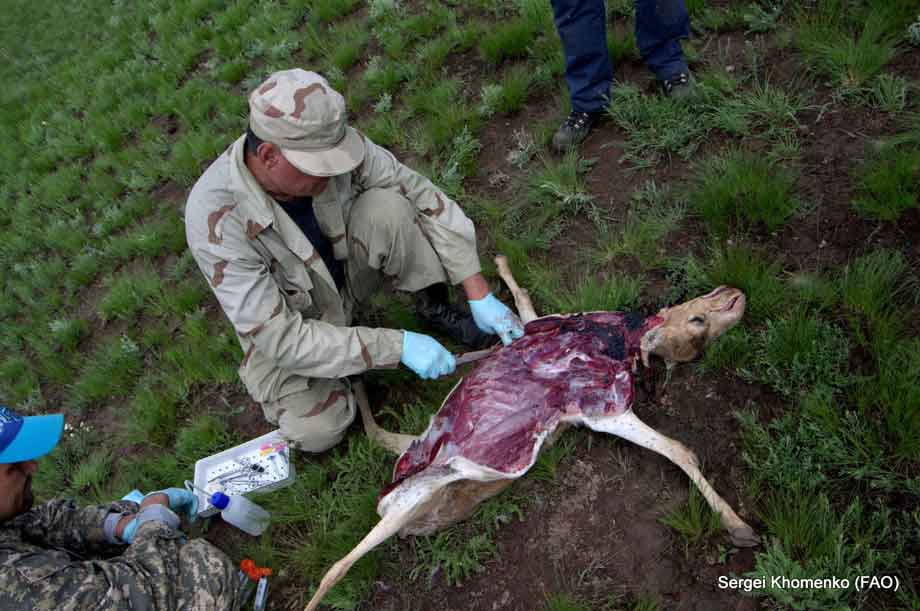Massive Die-Out Of Saiga Antelopes In Central Asia
By Marianne de Nazareth
30 May, 2015
Countercurrents.org

It's a shocking number, for those who are concerned about species loss. News is out that more than 120,000 saiga antelope, a mind boggling figure, have been confirmed dead in central Kazakhstan, representing more than a third of the global population. This is a major blow for conservation efforts, given that saigas have in the past ten years, only just started to recover from a global population size of less than 50,000 animals following a 95% crash in numbers.
According to information which is coming in, preliminary analysis indicates that a combination of environmental and biological factors is contributing to this catastrophic event, which has seen four large birth aggregations of this critically endangered antelope eradicated since mid-May this year. The most worrying fact is that it is primarily mothers and calves that are amongst the carcasses; not a single animal has survived in the affected herds.
Erlan Nysynbaev, Vice Minister of the Ministry of Agriculture of Kazakhstan stated “This loss is a huge blow for saiga conservation in Kazakhstan and in the world, given that 90% of the global saiga population is found in our country. It is very painful to witness this mass mortality. We established a working group that includes all relevant experts, including international ones, and are determined to identify the causes and undertake all possible efforts to avoid such events in the future.”
At the request of Kazakhstan, the Secretariat of the Convention on the Conservation of Migratory Species of Wild Animals (CMS) despatched an emergency mission last week with experts from the Royal Veterinary College in the United Kingdom and the Food and Agriculture Organization to assist on the ground with post-mortem examination, analysis and to contribute to the working group.
CMS Executive Secretary, Bradnee Chambers said “Authorities in Kazakhstan are responding quickly to this disaster and are working hard to solve the mystery behind this mass saiga die-off. I am pleased that the international expert mission we were able to send, at very short notice, is now contributing to these efforts".
According to Yury Grachev of the WWF, the saiga antelope is a major player in one of the most spectacular animal migrations. It faces an uncertain future due to hunting and loss of habitat. It's distinctive bulbous nose makes the saiga hardly iconic to look at for the conservation movement. The large humped nose hangs over the mouth of the saiga. The nose is flexible and inflatable so helps it to breathe clean air during dusty summers and warm air during cold winters. Over time, habitat loss and illegal hunting have dramatically cut population numbers.
During the summers its coat is sparse and cinnamon coloured, turning to a very thick white coat during the winter. The Saiga antelope has long, thin legs, weighs: 30 - 50kg, but is similar in size to a sheep. The Saiga form herds of 30-40 animals, however, during the migration season tens of thousands of saiga will travel together, forming part of one of the most spectacular migrations in the world.

It eats grasses, steppe lichens, herbs and shrubs but the population fall in saiga antelope has been dramatic. In the early 1990s numbers were over a million, but are now estimated to be around 50,000. The Mongolian sub-species (Saiga tatarica mongolica) is particularly at risk with an estimated population of just 750.
The Saiga antelope is a priority species which the WWF treats as one of the most ecologically, economically and/or culturally important species on our planet. And so efforts are being made to ensure such species can live and thrive in their natural habitats. The aerial survey conducted as part of the national monitoring programme earlier this year estimated that the Betpak-dala population numbered approximately 250,000 animals prior to this mass die-off, which has therefore halved the total population. It is likely that final estimates may extend beyond 120,000 dead saigas since the counting of carcasses by emergency response teams is continuing. It is however becoming clear that the mass die-off has come to an end and that several GPS-collared animals are still alive in herds that were not affected by the mortality event.
Mass mortality events are not unusual for saiga antelopes, with a case occurring as recently as 2010 with 12,000 dead animals. However, the scale of the current event is unprecedented relative to the total population size. Often these mass mortality events occur in the birth period, when saiga females come together in vast herds to all give birth within a peak period of less than one week.
“Saiga antelopes often have twins and populations are able to rebound quickly. Our hope is that if we can control what is driving these mass mortality events as well as tackle the number one threat to saigas – wildlife crime and poaching – populations will be able to recover. Collaboration among all stakeholders is vital. Kazakhstan is leading the way and I look forward to the Range States putting in place strong policies at the CMS Saiga meeting,” said Chambers.
So, why are the saiga so vulnerable? Hunting is a big reason as well as the break- up of the former USSR led to uncontrolled hunting. With increased rural poverty levels, the saiga is hunted for its meat. And the demand for the horn used in traditional Chinese medicine skewed the sex ratio so dramatically leading to a catastrophic drop in birth rates. The saiga has also had to face increased competition for grazing grounds from other species as natural habitat is claimed for agricultural use. Severe winters followed by summer droughts in recent years have also made it difficult for the population to recover.
According to information received from the members of the CMS expert mission, it is becoming clear that two secondary opportunistic pathogens, specifically Pasteurella and Clostridia, are contributing to the rapid and wide-spread die-off. However, the hunt for the fundamental drivers of the mass mortality continues since these bacteria are only lethal to an animal if its immune system is already weakened.
“Experts are working around the clock to investigate the impacts in terms of wildlife health of the relatively high rainfall observed this spring, the composition of the vegetation and other potential trigger factors including a suite of viruses. None of the data analysed to date indicates that rocket fuel is related to the mass die-off. Fresh laboratory results are becoming available every day,” says Aline Kühl-Stenzel, Terrestrial Species Officer at the UNEP/CMS Secretariat, who has been supporting the expert mission remotely from the Convention’s headquarters in Bonn, Germany.
Kazakhstan has been actively implementing the CMS Memorandum of Understanding concerning Conservation, Restoration and Sustainable Use of the Saiga Antelope), not least through establishing new protected areas and anti-poaching patrols. Other partners that have signed the MOU, namely the Frankfurt Zoological Society and the Association for the Conservation of Biodiversity of Kazakhstan (ACBK) have been providing funds, as well as technical and logistical support for the emergency response, including the CMS expert mission. The Saiga Conservation Alliance, another partner of the MOU, has provided scientific input.
The Convention on the Conservation of Migratory Species of Wild Animals (CMS) aims to conserve terrestrial, aquatic and avian migratory species throughout their range. It is an intergovernmental treaty, concluded under the aegis of the United Nations Environment Programme, concerned with the conservation of wildlife and habitats on a global scale. To date 120 State Parties have ratified the Convention. www.cms.int
The Memorandum of Understanding concerning Conservation, Restoration and Sustainable Use of the Saiga Antelope (Saiga spp.) is an intergovernmental instrument developed under the auspices of CMS dedicated to the conservation of saiga antelopes across their five Range States (Kazakhstan, Mongolia, the Russian Federation, Turkmenistan and Uzbekistan). The MOU has been in force since 2006 and has been signed by all Range States, as well as eight Cooperating Organizations, namely the Association for the Conservation of Biodiversity of Kazakhstan, Fauna and Flora International, the Frankfurt Zoological Society, the International Council for Game and Wildlife Conservation (CIC), IUCN/SSC, Saiga Conservation Alliance, Wildlife Conservation Society and WWF International.
In response to a request from Kazakhstan, the CMS Secretariat is sending out an expert mission today to strengthen work to identify the cause of the current saiga die-off. Latest official reports confirm that more than 27,000 adult saiga antelopes have died in the Betpak-dala population. The expert mission will now follow up on fresh reports that another part of the Betpak-dala population towards the west in Aktobe oblast may also be affected.
“We are very concerned by the scale and speed at which saiga antelopes are dying in central Kazakhstan,“ says Bradnee Chambers, Executive Secretary of the Convention on Migratory Species.
“We are working closely with the authorities and experts on the ground to identify the cause of this catastrophe and to guide action appropriately. Experts are currently being flown in and we are trying hard to mobilize funds in support.”
The CMS Secretariat has learned that more than 500 people with almost 100 cars are assisting the emergency response in Kostanay oblast in central Kazakhstan. Authorities and experts have been working closely together to investigate the situation and to minimize any potential risk of the infection spreading. The Association for the Conservation of Biodiversity of Kazakhstan ( ACBK), one of the key partners providing technical coordination for the CMS Saiga MOU, has been at the site in Kostanay from the onset of the mass mortality event last week and will provide technical assistance to the expert mission.

Samples from the affected saigas as well as the vegetation and soil of the area have been collected and are currently being analysed. "Symptoms of the saiga affected include foam around the mouth and diarrhoea. Primarily adult females and newly born calves have been affected, since mid-May is the period when females aggregate in vast herds to all give birth within a peak period of only one week. It appears that one or several large birth aggregations have been eradicated", says Aline Kühl-Stenzel, Terrestrial Species Officer at the CMS Secretariat.
The mass die-off destroys hope that the Betpak-dala population has once again reached a stable level. Population figures for 2014 estimated the size of this population around 200,000 animals, with perhaps a total of 260,000 saigas in the whole of the range. These numbers will now have to be dramatically revised and conservation action will have to be significantly strengthened as a result.
The CMS Secretariat in close collaboration with the CITES Secretariat is currently preparing a meeting of all five Signatories of the Saiga MOU (Kazakhstan, Mongolia, the Russian Federation, Turkmenistan and Uzbekistan), as well as consumer countries of saiga products, to review progress and to agree to urgently needed measures, not least related to disease and the Betpak-dala population.
Marianne de Nazareth is a freelance Science and Environment Journalist and registered PhD scholar with the Madurai Kamaraj University
Tags
.
Comments are moderated

